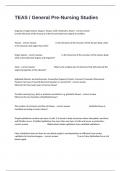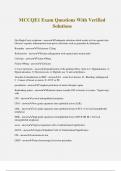Exam (elaborations)
TEAS / General Pre-Nursing Studies Certification Revised Exam Questions With Multiple Choices And Verified Answers.
- Course
- Institution
Organism, Organ System, Organs, Tissues, Cells, Molecules, Atoms - correct answer List the hierarchy of the structure of the human body from largest to smallest Tissues - correct answer In the hierarchy of the structure of...
[Show more]




